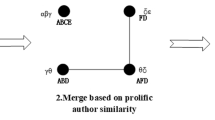Abstract
This article advances the thinking of Thompson, Conaway and Dolan’s “Undergraduate students’ development of social, cultural, and human capital in a network research experience”. Set against a background of change in the biosciences, and participation, it firstly explores ideas of what it means to be a scientist, then challenges the current view of the apprenticeship model of career trajectory, before going onto to consider the nature of participation in communities of practice and issues related to underrepresented minority groups in science. Central to this analysis is the place that the notion of habitus plays in thinking about shaping future scientists and the how this can both support, but also suppress, opportunities for individuals through a maintenance of the status quo.
Similar content being viewed by others
References
Aschbacher, P. R., Li, E., & Roth, E. J. (2010). Is science me? High school students’ identities, participation and aspirations in science, engineering, and medicine. Journal of Research in Science Teaching, 47, 564–582. doi:10.1002/tea.20353.
Bernier, A., Larose, S., & Soucy, N. (2005). Academic mentoring in college: The interactive role of student’s and mentor’s interpersonal dispositions. Research in Higher Education, 46, 29–51. doi:10.1007/s11162-004-6288-5.
Bernstein, B. (2003). The structuring of pedagogic discourse: Structuring of pedagogic discourse Vol 4(Class, codes and control). London: Routledge.
Billet, S. (2004). Learning through work: Workplace participatory practices. In H. Rainbird, A. Fuller, & A. Munro (Eds.), Workplace learning in context (pp. 109–125). London: Routledge.
Bourdieu, P. (1977). Outline of a theory of practice (Vol. 16). Cambridge: Cambridge University Press.
DeWitt, J., Archer, L., Osborne, J., Dillon, J., Willis, B., & Wong, B. (2011). High aspirations but low progression: The science aspirations–careers paradox amongst minority ethnic students. International Journal of Science and Mathematics Education, 9, 243–271. doi:10.1007/s10763-010-9245-0.
Fox, M. F., Sonnert, G., & Nikiforova, I. (2009). Successful programs for undergraduate women in science and engineering: Adapting versus adopting the institutional environment. Research in Higher Education, 50, 333–353. doi:10.1007/s11162-009-9120-4.
Hunter, A. B., Laursen, S. L., & Seymour, E. (2007). Becoming a scientist: The role of undergraduate research in students’ cognitive, personal, and professional development. Science Education, 91, 36–74. doi:10.1002/sce.20173.
Jawitz, J. (2009). Learning in the academic workplace: The harmonization of the collective and the individual habitus. Studies in Higher Education, 34, 601–614. doi:10.1080/03075070802556149.
Knight, P. T., & Trowler, P. R. (2000). Department-level cultures and the improvement of learning and teaching. Studies in Higher Education, 25, 69–83. doi:10.1080/030750700116028.
Lareau, A., & Weininger, E. B. (2003). Cultural capital in educational research: A critical assessment. Theory and Society, 32, 567–606.
Lave, J., & Wenger, E. (1991). Situated learning: Legitimate peripheral participation. Cambridge: Cambridge University Press.
Maldonado, D. E. Z., Rhoads, R., & Buenavista, T. L. (2005). The student-initiated retention project: Theoretical contributions and the role of self-empowerment. American Educational Research Journal, 42, 605–638. doi:10.3102/00028312042004605.
National Science Foundation, Division of Science Resources Statistics. (2009). Women, minorities and persons with disabilities in science and engineering (NSF 09-305). Washington, DC: National Science Foundation.
Ovink, S. M., & Veazey, B. D. (2011). More than “getting us through”: A case study in cultural capital enrichment of underrepresented minority undergraduates. Research in Higher Education, 52, 370–394. doi:10.1007/s11162-010-9198-8.
Stake, J. E. (2006). The critical mediating role of social encouragement for science motivation and confidence among high school girls and boys. Journal of Applied Social Psychology, 36, 1017–1045. doi:10.1111/j.0021-9029.2006.00053.x.
Tenenbaum, H. R., & Leaper, C. (2003). Parent–child conversations about science: The socialization of gender inequities? Developmental Psychology, 39, 34–47. doi:10.1037/0012-1649.39.1.34.
Wenger, E. (1998). Communities of practice: Learning, meaning, and identity. Cambridge: Cambridge University Press.
Author information
Authors and Affiliations
Corresponding author
Additional information
This review essay addresses issues raised in Jennifer Thompson, Evan Conaway and Erin Dolan’s paper entitled: undergraduate students’ development of social, cultural, and human capital in a network research experience. doi:10.1007/s11422-014-9628-6.
Rights and permissions
About this article
Cite this article
Davies, P. Apprenticeship in science research: whom does it serve?. Cult Stud of Sci Educ 11, 991–997 (2016). https://doi.org/10.1007/s11422-015-9661-0
Received:
Accepted:
Published:
Issue Date:
DOI: https://doi.org/10.1007/s11422-015-9661-0



